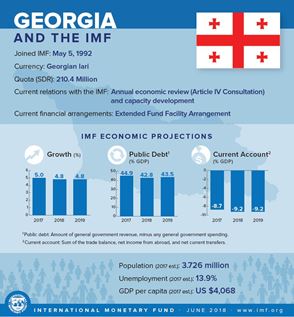Imf Regional Economic Outlook Europe
economic europe regionalGrowth is gathering momentum in most of Central Eastern and South-Eastern Europe CESEE in the wake of the recovery in the euro area. Regional Economic Outlook October 2020 Europe Whatever It Takes.
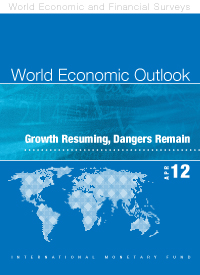 Imf World Economic Outlook Weo Growth Resuming Dangers Remain April 2012 Table Of Contents
Imf World Economic Outlook Weo Growth Resuming Dangers Remain April 2012 Table Of Contents
Excluding the largest economiesRussia and Turkeythe IMFs latest Regional Economic Issues report projects the region to grow 23 percent in 2014 almost twice last years pace.
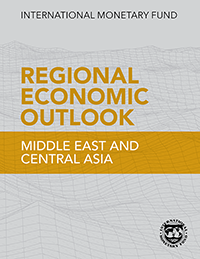
Imf regional economic outlook europe. Real GDP increased by 28 percent in 2017 up from 18 percent in 2016. Europes Response to COVID-19. Europe anticipates that recovery in the region will solidify with recoveries in advanced and emerging Europe likely to be mutually reinforcing.
Advanced Europe continues to absorb most of emerging Europes exports while the role of emerging Europe as a market for advanced Europe will expand. Europes contraction is ending but the recovery is fragile. Chapters discuss the outlook and policy priorities for.
Chapters discuss the outlook and policy priorities for. Europes Response to COVID-19 published on by INTERNATIONAL MONETARY FUND. This projection broadly unchanged from the April 2019 World Economic Outlook masks significant differences between advanced and emerging Europe.
Europes economy continued to expand in the first half of 2018 although at a slower-than-expected pace specifically in advanced Europe. There are five regions Asia and Pacific Middle East and Central Asia Sub-Saharan Africa Western Hemisphere and Europe. Regional Economic Outlook for Europe Fall 2020 October 21 2020 Description.
Regional Economic Outlook. Policymakers should look beyond the crisis to secure a durable upswing and address the threats to potential growth from the crisis and the continents well-known structural rigidities. The ongoing resurgence of infections across Europe presents perhaps the greatest downside risk at this stage.
Nonetheless growth is set to ease in 2008 in nearly all countries. The COVID-19 pandemic has hit Europe particularly hard we project that the economic contraction in 2020 will be among the worlds largest. A modest recovery is forecast for 2020 with growth reaching 18 percent as global trade is expected to pick up and some economies recover from past stresses.
After strong growth in 2017 and early 2018 global economic activity slowed notably in the second half of last year reflecting a confluence of factors affecting major economies. Regional Economic Outlook October 2020 Europe. This is certainly good news.
They address regional policy developments and challenges and provide country-specific data and analysis including through analytical pieces on issues of interest to a particular region. Europes Response to COVID-19 The COVID-19 pandemic has caused dramatic loss of human life and major damage to the European economy but thanks to an exceptionally strong policy response potentially devastating outcomes have been avoided. Policymakers will need to deal up front with the financial market turmoil while implementing fiscal consolidation and structural reforms including in the financial sector to address vulnerabilities raise medium-term growth prospects.
Credit growth has finally picked up which is helping Europes banks to rebuild profitability. The May 2011 Regional Economic Outlook. Chapter 1 was prepared by a staff team including Vizhdan Boranova Raju Huidrom Sylwia Nowak Faezeh Raei and Yan Sun and was led by Emil Stavrev.
Europe continues to enjoy a strong growth spurt. Global growth is now projected to slow from 36 percent in 2018 to 33 percent in 2019 before returning to 36 percent in 2020. REGIONAL ECONOMIC OUTLOOK.
The May 2011 Regional Economic Outlook. Europe anticipates that recovery in the region will solidify with recoveries in advanced and emerging Europe likely to be mutually reinforcing. The European recovery is strengthening and broadening appreciably.
These are large upward revisions-05 and 02 percentage points for 2017 and 2018 respectivelyrelative to the April World Economic Outlook. The reports analytical work stresses the uncertainty surrounding potential growth estimates and the more volatile environment faced by emerging. We project that economic activity in Europe this year will decline by 7 and rebound by 47 in 2021.
Europe was prepared by a staff of the IMFs European Department under the general guidance of Jörg Decressin. Here are six charts which tell the story of Europes economic health and its prospects for the near- and. Real GDP growth is projected at 24 percent in 2017 up from 17 percent in 2016 before easing to 21 percent in 2018.
But the outlook is less favorable with several forces likely to hamper economic growth. The expansion is largely driven by domestic demand with investment increasingly contributing. European real GDP is now projected to contract by 7 percent in 2020 its biggest decline since World War II followed by a rebound of 47 percent in 2021.
Strong fundamentals should allow Europe to weather financial turbulence relatively well. Regional Economic Outlook October 2020 Europe. The coronavirus disease COVID-19 pandemic has caused dramatic loss of life and major damage to the European economy but thanks to an exceptionally strong policy response more devastating outcomes have been avoided.
Driven by domestic demand economic activity continued to expand in the first half of 2018 the IMF said in its latest health check of Europes economy. Advanced Europe continues to absorb most of emerging Europes exports while the role of emerging Europe as a market for advanced Europe will expand. On balance Europes growth is projected to decline from 23 percent in 2018 to 14 percent in 2019.
But the outlook for 2020 remains bleak and the recovery will be partial and uneven. Growth has firmed up in many European economies and the forecast is for more of the same. Countries in Europe responded swiftly to the pandemic which helped avoid worse outcomes.
Europe Hitting Its Stride. But the recoverys strength will depend crucially on the course of the pandemic peoples behavior and the degree of continued economic policy support. The May 2018 Regional Economic Outlook.
The Rise of Corporate Market Power and Its Macroeconomic. The recovery path is exceptionally uncertain.
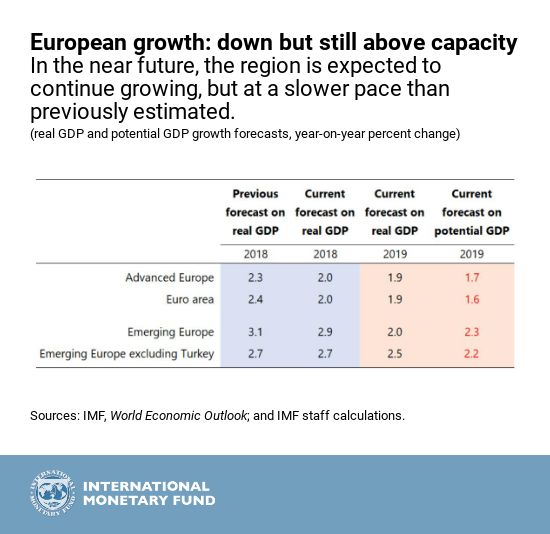
 Data Visualization En Erdf Eu Funding Central And Eastern Europe Data Visualization Region
Data Visualization En Erdf Eu Funding Central And Eastern Europe Data Visualization Region
 The Potential For Growth And Africa S Informal Economy Economy Global Economy Book Activities
The Potential For Growth And Africa S Informal Economy Economy Global Economy Book Activities
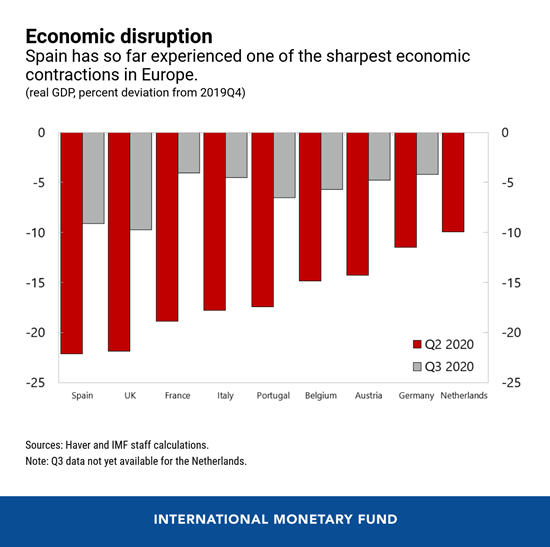
 World Economic Outlook Imf Blog
World Economic Outlook Imf Blog
 World Trade Volumes Electric Aircraft Aircraft Engine World Trade
World Trade Volumes Electric Aircraft Aircraft Engine World Trade
 Vienna 2 Initiative Draws Attention To Weak Credit Growth And Special Challenges For South Eastern Europe Core Sector Communique Debt Relief Credit Consolidation Volkswagen Logo
Vienna 2 Initiative Draws Attention To Weak Credit Growth And Special Challenges For South Eastern Europe Core Sector Communique Debt Relief Credit Consolidation Volkswagen Logo
 Growth In Europe And North America Continues To Lag Other Regions Issue Economics Trade Growth Pwc Wef Davos Economy
Growth In Europe And North America Continues To Lag Other Regions Issue Economics Trade Growth Pwc Wef Davos Economy
 Economic Forecast Economic Map Forecast Economic Trends
Economic Forecast Economic Map Forecast Economic Trends
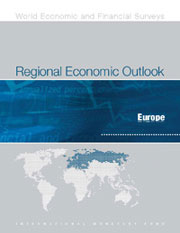
Vietnam Gdp Growth Forecast To Stay Ahead Regional Peers At 2 7 In 2020 Imf
 Rhodium Group The Imf S World Economic Outlook For China Slower And Less Trade Surplus World China Trade Trading
Rhodium Group The Imf S World Economic Outlook For China Slower And Less Trade Surplus World China Trade Trading
 Imf International Monetary Fund 2018 Regional Economic Outlook Sub Saharan Africa Domestic Revenue Mobilization And Region Africa Economic Development
Imf International Monetary Fund 2018 Regional Economic Outlook Sub Saharan Africa Domestic Revenue Mobilization And Region Africa Economic Development

